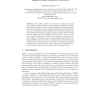Free Online Productivity Tools
i2Speak
i2Symbol
i2OCR
iTex2Img
iWeb2Print
iWeb2Shot
i2Type
iPdf2Split
iPdf2Merge
i2Bopomofo
i2Arabic
i2Style
i2Image
i2PDF
iLatex2Rtf
Sci2ools
KES
2004
Springer
2004
Springer
Detection of Dynamical Transitions in Biomedical Signals Using Nonlinear Methods
The ability to detect the existence of nonlinear dynamics may facilitate medical diagnostics for identifying, monitoring and predicting transitions from health to sickness. Detection of such transitions depends on the quality of the available biomedical signals and the relevance of the nonlinear statistics employed. The dangers of using irrelevant statistics are discussed. A simple intuitive nonlinear statistic, which evaluates changes in the distribution of points in state space is shown to be capable of detecting both linear and nonlinear dynamical transitions. This new technique, known as multi-dimensional probability evolution (MDPE), is illustrated using a synthetic signal obtained by mixing stochastic and a chaotic processes. Its utility in detecting transitions in biomedical data is demonstrated using a database of electrocardiograms collected from subjects who experienced partial epileptic seizures.
| Added | 02 Jul 2010 |
| Updated | 02 Jul 2010 |
| Type | Conference |
| Year | 2004 |
| Where | KES |
| Authors | Patrick E. McSharry |
Comments (0)

